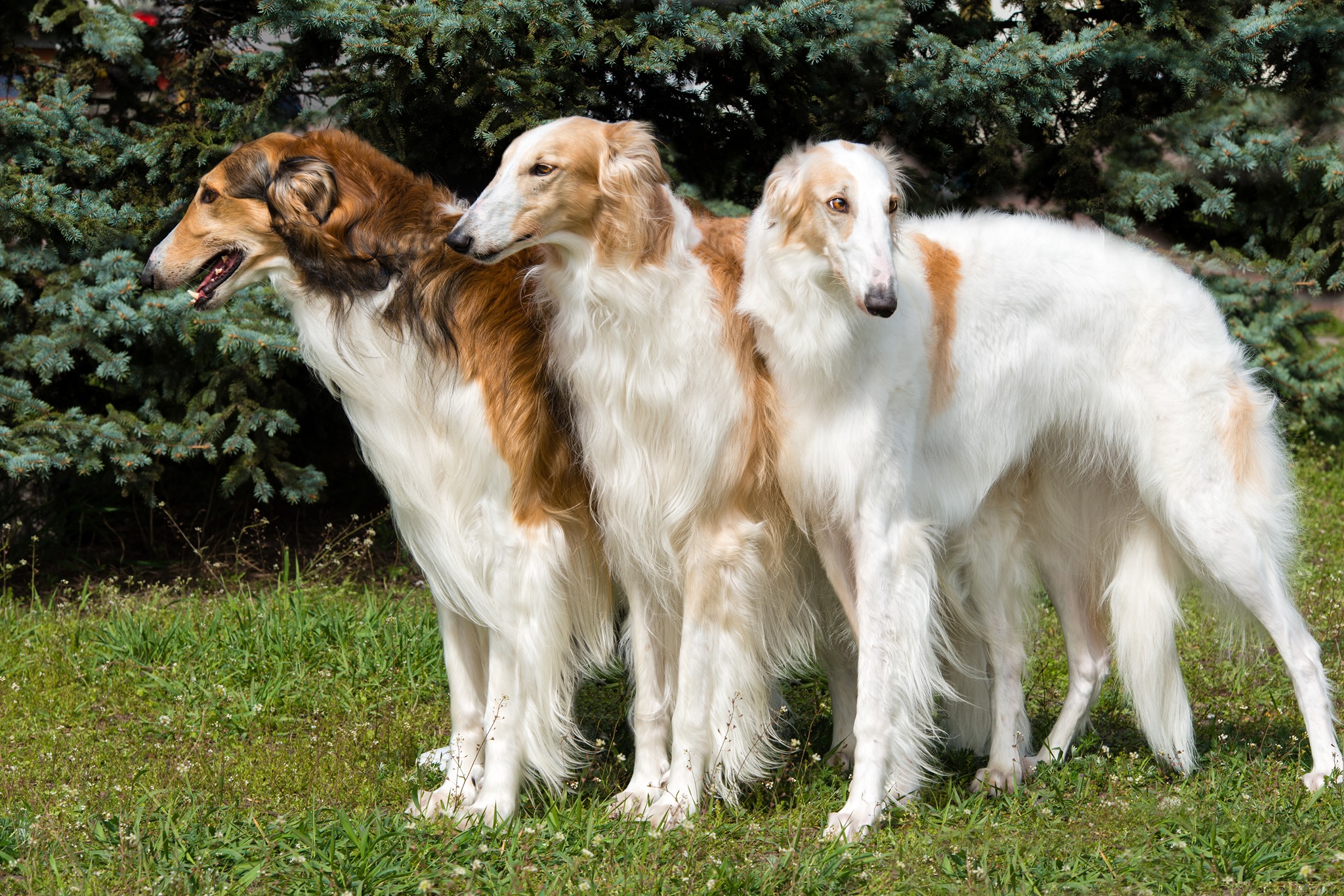
Preliminary breed summary: Borzoi!
Dr. Niels Pedersen recently published another very preliminary breed report on the Borzoi breed! Breeders will soon be receiving their individual reports, which is always exciting and requires some learning to put into use. With their data, they can begin finding the least related available mates and planning their breedings!
So, what did UC Davis’ professor emeritus Dr. Niels Pedersen DVM, PhD find with regard to the Borzoi in this preliminary analysis? The following article summarizes the full breed report written by Dr. Pedersen. You can find the full report here.
This report is based on the testing of 31 carefully selected Borzoi; chosen to represent unrelated bloodlines within the breed. While 31 individuals is not enough for a final analysis, it should give a good initial approximation of the status of the breed. We need more Borzoi to be contributed, so please consider adding yours!
How inbred is the typical Borzoi?
A part of the UC Davis canine diversity test is a measurement that estimates how inbred a dog is. This estimate, called Internal Relatedness or IR, is a positive measure from 0 to 1 when a dog is inbred, and a negative measure from 0 to -1 when the dog is outbred. An outbred puppy would inherit genetics from its sire that were very different from those it inherited from its dam. An inbred puppy would inherit many of exact same genetics from both dam and sire. Being outbred reduces the likelihood of known and unidentified recessive component diseases expressing in individuals.
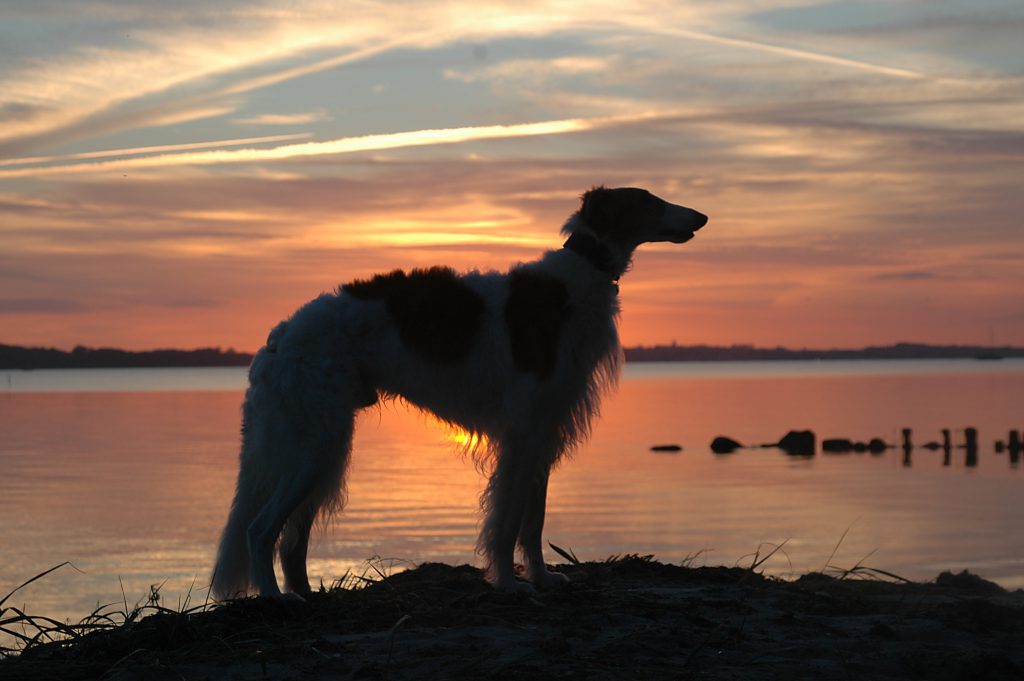
So, how inbred or outbred are the individuals in the Borzoi breed?
From the preliminary report:
The most outbred dog in the population had an IR score of -0.297, while the most inbred dog in the group had an IR score of 0.369, while the mean (average) IR score for the group was 0.034. The IR curve created from this data was also somewhat biphasic, with one group having IR scores <0.034 and a second group with scores >0.034 (Fig. 4). This latter group contained at least one individual that was more inbred (IR>0.25) than offspring of full sibling parents.
Dr. Niels Pedersen 2019
To translate – some of the breed has very high levels of inbreeding, and because we can’t necessarily detect this without DNA testing and analysis, they could benefit from predictive software aiding in selection of breeding mates, to ensure that future breedings are not too close, risking health as a result.
How much biodiversity exists in the Borzoi today?
Dr. Pedersen’s reports create several different analyses of the data from the VGL canine diversity test in order to assess the total amount of biodiversity within each breed. Many of these measures together give us an overall picture of the state of the breed and as a result we can make informed decisions on breed management.
The best explanation I’ve yet read is from BetterBred Founder Natalie, and as a result we will share it again here!
Most breeders think of DNA as coming in two options- a good gene, or a mutant gene – like it is in many DNA tests. In fact, there can be many versions of each gene or (in this case) marker in a single place on the DNA – like a t-shirt that is available in different colors. The more variants there are, the more information we have about the population genetics of a breed. In more inbred breeds, there are fewer variants for each marker. So to use our analogy, an inbred breed might have only a few colors available in t-shirts, whereas a diverse breed will have t-shirts in many colors. Apart from the relatively small number of genes that make up specific, visible breed traits, the rest of the gene pool is generally healthier when there’s a lot of variation for each marker.
Unfortunately when breeders select too strictly for too long and for very specific traits, there can be an unintended loss of variation in the parts of the DNA that thrive with more variation. A good way to assess whether that good variation has been impacted is by using the markers found in the VGL canine diversity test. Because they are considered neutral – or not associated with any specific known trait – they are great for assessing genetic diversity. In breeds with ample diversity, there will be lots of variations for each marker (lots of colors in the t-shirt drawer.)
But what if you have a breed without much variation? Well, this happens, and can happen quite often. In this case the best thing breeders can do is try to make sure the variants that are in the breed are well distributed – so there are plenty of all of them in the breed. Imagine a t-shirt drawer with lots and lots of red t-shirts but only one blue t-shirt and one green t-shirt. If you lose one of the red ones, it doesn’t change much about the t-shirt drawer – there are lots of other red ones. But if you lose either the blue or green one, the variation is seriously diminished. If, on the other hand a third of the shirts are red, and a third are green and a third are blue, then it’s a lot harder to lose the existing variation in the drawer, even if you lose one once in a while, and even though there are only 3 colors.
The Borzoi’s biodiversity
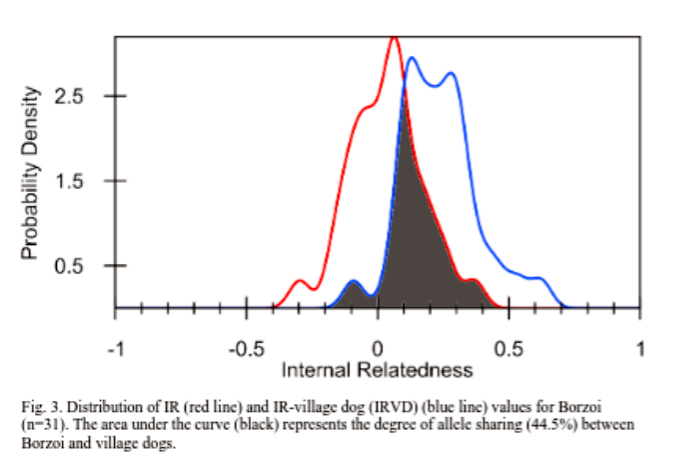
Another use of an individual’s inbreeding value: we can look at the inbreeding level of all individuals in the breed in aggregate – meaning the whole breed altogether. When a whole breed is very inbred on the same few ancestors, it can result in very little remaining biodiversity within the breed. Then, by adjusting those inbreeding values in comparison to the data from village dogs (often considered “ideal” for biodiversity), researchers can estimate the remaining biodiversity of a breed compared to all the diversity that once existed in dog prior to breed formation.
So when this investigation was done for Borzoi, what did Dr. Pedersen see?
The IRVD graph, similar to the IR graph, tended to be bimodal with one half of the dogs having IRVD scores >0.236 and one half with IRVD score <0.236. Therefore, if this group of dogs were village dogs, one-half of them would be considered more inbred than offspring of full sibling parents.
The IRVD curve for the Borzois tested was shifted to the right of the IR curve, and the area of overlap was 44.5%(Fig. 3). This figure is close to the 36.8% of retained genetic diversity calculated from a somewhat different population, i.e., all canids ever tested at the VGL (Tables 1, 2). This level of retained village dog genetic diversity is lower than the 60% or so retained diversity observed in the Miniature/toy poodle or 54% in Labrador Retriever, and much higher than the 23% for Irish wolfhound, 15% in Doberman Pinschers and 7% in Swedish Vallhund.
Dr. Niels Pedersen 2019
This assessment indicates that there has been a significant depletion of genetic diversity in this breed, but let’s look at the data another way:
A secondary way to estimate the loss of biodiversity due to breed formation and breeding choices post-formation is to look at the average number of alleles found at each tested locus and to compare those to the village dogs. When looking at the number of alleles found, we might consider two things: the average number of alleles found in total (Na), and the average number of alleles that are effectively contributing to the population (Ne – effective alleles). Going back to the t-shirt analogy above, say we have 10 t-shirts, and 8 of them are red and one is green and one is yellow. The total number of shirt colors is 3, however the majority color is red, therefore our “effective” t-shirt color would be only 1.
So, if we look at these numbers what do we find out about this population?

(T)he 31 Borzois had an average of 5.58 alleles/loci (Na). This is higher than for the Shiloh
Shepherd (Na=4.0), Lakeland Terrier (Na=4.24), Swedish Vallhund (Na=4.91) and Irish Red and White Setter (Na=5.09); similar to the Llewellin Setter (Na=5.94) and Flat-coated Retriever (Na=5.94); but lower than large and genetically diverse breeds such as the Labrador Retriever (Na=7.33), Golden Retriever(Na=8.39) and Miniature Poodle (Na=8.91). However, the average number of alleles is less important than the number of alleles that have the greatest genetic influence on heterozygosity, a figure known as average effective alleles/loci or Ne. The Ne in this group of dogs averaged 3.43 effective alleles per locus.(…)
On average, the alleles identified in this group of 30 dogs represented 5.6/15.4=36.3% of alleles known to exist in all canids tested at the VGL. This is higher than the Swedish Vallhund(31.9%); similar to the Flat-coated Retriever (38.6%), Irish Red and White Setter (34.8%) and Magyar Agar (40.4%); but lower than breeds such as the Golden Retriever (54.5%), Toy Poodle (55.6%) and Standard Poodle (58%).
Dr. Niels Pedersen 2019
Dr. Pedersen discovered that the breed is only effectively using about 61% of it’s total available biodiversity. How does a breed community increase this? They identify individuals who may have unusual genetics for the population, and work to preserve those genetics and redistribute them in the population at large.
These findings may change as more dogs are tested, and it is imperative for conscientious breeders to find and preserve any as yet unseen diversity. To do that, they should test as many dogs as possible, and keeping a keen eye out for healthy unusual or long isolated lines where perhaps there may be more variation.
Breed relationships
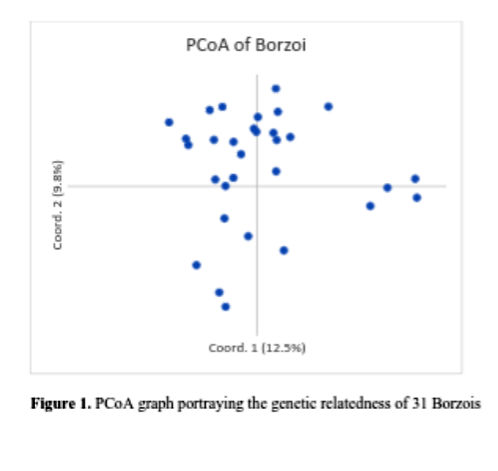
Another use of the data from the VGL canine diversity test is to see how the individuals within the population fit in relation to one another. What do we see when we look at this analysis, called the PCoA graph?
The 31 Borzois formed a single population (i.e., breed)in PCoa (Fig. 1}. However, several individuals were outliers from the main population, although not sufficiently distant to constitute a variety. These individuals, all from Australia, cluster as a small sub-population to the right of the main group. A possible third group of 3 dogs below the main population may also be significant outliers. This effect is commonly seen in individuals from the same breed that have been bred distant geographic isolation for some time.
Dr. Niels Pedersen 2019
Interestingly, it appears that dogs in Australia are clustering away from those elsewhere. This is not always the case for dog breeds and is good for breeders in each population, because importing dogs may indeed introduce different genetics to compliment breeding programs.
Additionally, the breed’s PCoA can be compared to other breeds. Dr. Pedersen chose to compare to the Irish Wolfhound with the Irish Red and White Setter. In this comparison, it appears there are individual Borzois that may be outliers in comparison to the rest of the breed. From the report:
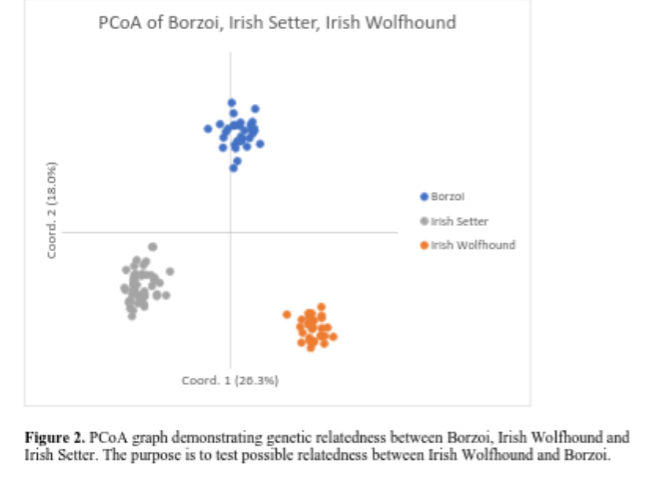
The degree of relatedness of individuals within a breed can be further emphasized by comparing the 31 Borzoi with genetically distinct breeds, such as the Irish Setter and Irish Red and White Setter(Fig. 2). These breeds have parallel histories and are from the same region. This comparison shows the three breeds to be genetically distinct, but with tightening in the relationship of individuals within each breed. It is noteworthy, however, that several Borzois still remained genetically distinguishable from the bulk of the breed-4 individuals to the right of the main population and 3-6 below. This indicates that several lineages still remain genotypically (and phenotypically?) distinguishable from the main population, although not to the level of varieties such as American and Japanese Akita or black vs. peppered Giant Schnauzers.”
It will be interesting to see if these dogs are outliers once run through the BetterBred software program and whether other tested dogs will be found like them.
The immune system
The UC Davis VGL canine diversity test can identify more regions of the DLA than any other test available today. The DLA, called Dog Leukocyte Antigen, is the region of the DNA that codes for the immune system in the dog. There are three regions, Class I, Class II and Class III. This test identifies both Class I and II haplotypes (a haplotype is a tightly linked group of genes within an organism that is inherited as a group from a single parent). To learn more about the DLA, read here.
From the report:
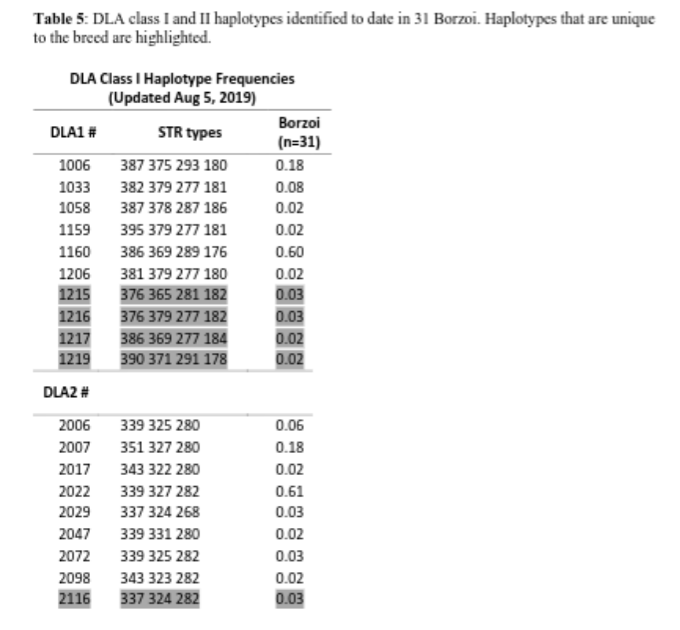
The 31 Borzoi in this study possessed 10 DLA class I and 9 DLA class II haplotypes (Table 5). Four class I (1215-1217, 1219) and one class II (2116) were unique to the breed and the rest shared with a number of other breeds (Table 6). One class I (1160) and one class II (2022) haplotypes occurred in 60% of the dogs tested, while another class I (1006) and class II (2007) haplotype were observed in 18% of dogs. These high incidence haplotypes found in 78% of the dogs were in strong linkage disequilibrium (LD), forming larger 1160/2022 and 1006/2007 haplotypes. All of the remaining haplotypes occurred at incidences ranging from 2-8%.
Dr. Niels Pedersen 2019
The number of DLA class I and II haplotypes found in these 31 Borzoi was among the lowest of any breed studied to date. The numbers of DLA class I (n=10) and II (n=9) haplotypes found in Borzois were higher than the Swedish Vallhund (6,4) and Shiloh Shepherd (7, 6); somewhat lower than Giant Schnauzer (14/15), Samoyed (13/12) and Shiba Inu (16/15); and much lower than Golden Retriever (26/23) and Miniature Poodle 12(33/ 23).If these 31 dogs are representative of the breed as a whole, it would suggest that two founder dogs or closely related bloodlines have played dominant roles in the breed.However, the fact that several low incidence haplotypes appear to be unique to the breed, also that dogs of these ancestries were also important to the breed’s standard and closely preserved
Additionally, the report notes that the Borzoi share DLA haplotypes with the following breeds in particular, Black Russian Terriers, Havanese, Irish Red and White Setter, Labrador Retriever, Doberman Pinschers, Samoyed, Giant Schnauzer, Shiba Inu, English Bulldog and American Akita.
In summary on the DLA: The Borzoi have two DLA haplotypes contributing to the immune system of the majority of Borzoi – while there are several DLA haplotypes that are not well represented. Breeders can use this testing to redistribute these haplotypes so that they are not lost to drift. As stated by Dr. Pedersen in his conclusion below, the lack of biodiversity in the DLA is worrisome. When more dogs are added to the study, there is possibility that more DLA haplotypes will be found.
Conclusions
The following conclusions from Dr. Pedersen sum up the findings from the 31 tested Borzoi.
The Borzoi also lack diversity in the DLA regions. Seventy eight percent of the individuals tested possessed one or two copies of the 1006/2007 or 1160/2022 class I/II linked haplotypes. This is evidence that two founders, or closely related founder lines, have contributed disproportionately to the breed’s evolution. However, the fact that these haplotypes are in equilibrium with the rest of the genome indicates that this imbalance occurred at the time of the founding and has become fixed/equilibrated over the time, and not from some more recent genetic bottleneck.
Dr. Niels Pedersen 2019
Although it appears that contemporary Borzoi have a very narrow genetic base, a lack of genetic diversity is not in itself bad, providing the founder population was relatively free of deleterious genetic traits and breeders have been judicious in avoiding any artificial genetic bottlenecks that may cause either a loss or imbalance of original diversity. The breed is surprisingly clear of breed-specific heritable disease traits and enjoys a good lifespan compared to other large dog breeds. The health problems that exist are of a complex genetic basis and are common to many dog breeds and even mongrels [11]. These traits common to modern dogs have most likely been inherited from generation to generation as dogs underwent progressively more intense human-directed artificial selection.
The lack of genetic diversity in the DLA class I and II region of these 31 Borzoi is troublesome, but it is uncertain what it means. Certain DLA class I and II haplotypes have been associated with specific autoimmune diseases in certain breeds[13], but autoimmune disorders other than hypothyroidism have not been documented as serious problems in Borzoi. Nevertheless, it is important that breeders maintain as much diversity and heterozygosity in the DLA region as possible.
Based on this preliminary report, it will be of great importance to conserve the existing biodiversity so further depletion does not occur due to random loss of alleles – called genetic drift. Breeders can do this by testing their dogs and placing a priority on healthy dogs with less well represented genetics in comparison to the rest of the population, provided they are good representatives of the breed. Using our tools designed to identify these individuals, Average Genetic Relatedness (AGR) and Outlier Index (OI) breeders can allow breeders to select these dogs, as well as to simulate what to expect in potential litters. Special attention might be warranted at the less typical DLA haplotypes so they are not lost to genetic drift.
Hopefully with further analysis and more dogs submitted to the study, more biodiversity will be found within the breed and successful management and conservation of that existing diversity can begin.
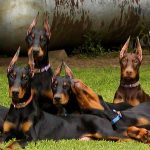 Previous Post
Previous Post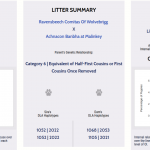 Next Post
Next Post


